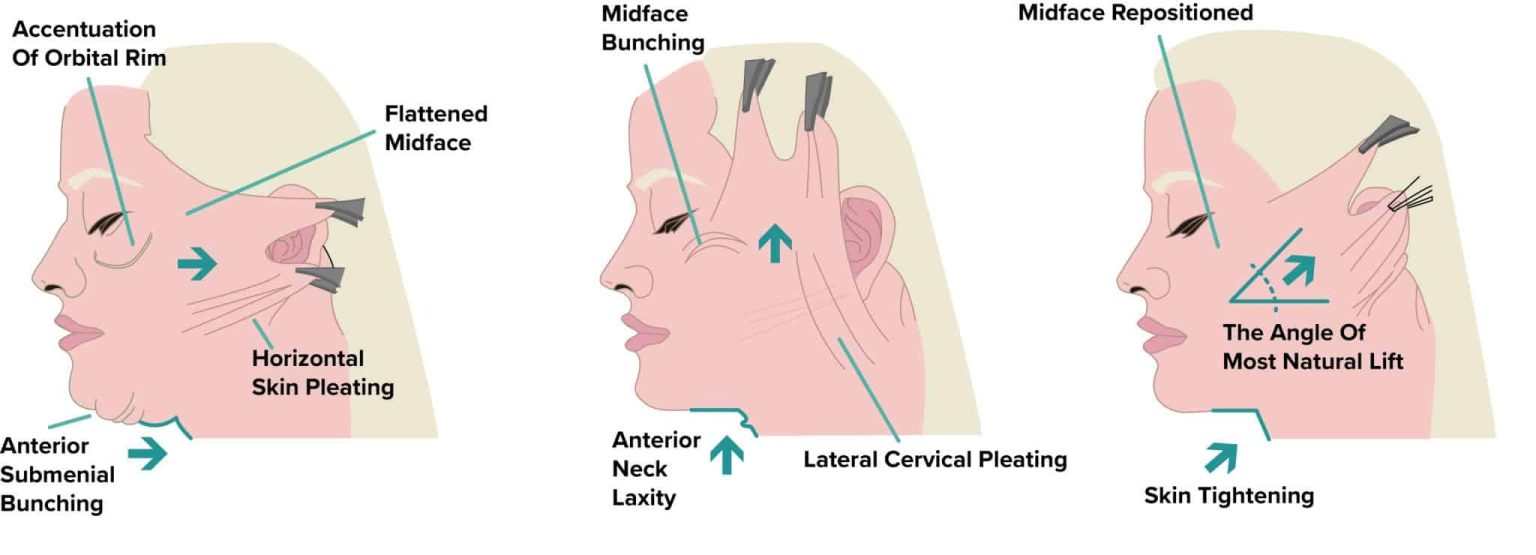Face Lift
As we grow older, signs of aging become more apparent throughout our face. One of the earliest signs of aging is the development of jowling. This occurs along the jawline and is evidenced by tissue laxity and fat pad descent. Add this to the overall volume loss, increased skin laxity and development of folds and rhytids as we age, and patients begin to look much older than they feel. With the adoption of healthier lifestyles, well-balanced diets and improved medical care, patients want their external appearance to match how they feel on the inside. A facelift is one option to address some of these concerns.
Facelifting improves sagging skin and muscle. It primarily addresses the lower half of the face and neck, and it can be combined with other procedures for more comprehensive facial rejuvenation. Our clinic is well versed in all types and aspects of facelift surgery, including full face and neck lifts, mini or short incision facelifts and revision facelifts. We use the newest minimally invasive techniques to bring a tailored approach to each patient, specifically addressing their needs and wishes. We do not believe in the overdone, “windswept,” artificial appearance that was common in the past, resulting in poor outcomes, short longevity and noticeable scarring. Our technique is designed to provide patients with long-lasting, natural results.
Procedure Description
We take an individualized approach to each patient and tailor facelifts accordingly. For those patients with minimal neck banding and thin necks, a mini or short incision facelift is an option. This will primarily address the jowls and jawline. For patients with more advanced signs of aging, heavy necks, significant neck banding or skin laxity, a traditional facelift is recommended. This procedure includes a small incision under the chin, which allows the surgeon to gain access to the anterior neck to tighten the platysma muscle and remove any redundant fat.

Both procedures involve making easily concealed incisions along the hairline and within natural skin creases around the ear. The skin is then elevated to gain access to the underlying SMAS (superficial muscular aponeurotic system) layer. This is a muscular/facial layer that is continuous with the platysma in the neck. It is also the workhorse of the facelift. The SMAS layer is then elevated off the underlying parotid gland and deep facial musculature in the deep plane. Once adequately elevated to allow for a smooth, non-tethered lift, the SMAS is trimmed and resuspended in a more youthful position.
A facelift can also be combined with other procedures on the face, such as blepharoplasty (eyelid surgery), fat transfer, brow lift or chin augmentation, for optimal facial rejuvenation.


Recovery
Following their procedure, patients can go home the same day. We recommend someone be with the patient at least the first night and can arrange for a home nursing service if desired. There will be a facelift dressing in place which is to remain on overnight. There are no surgical drains to worry about and every patient is seen in the office the following day. At this visit, the dressing is removed, the healing process is examined, incisions cleansed, and wound care is taught. The patient returns for suture removal one week later.
Most patients do not experience significant pain and are surprised at how well they feel in the early recovery period. Pain medication is prescribed for pain relief, but most patients can wean themselves off in one to two days, taking Tylenol only as needed.
FAQ
Am I a candidate for facelift surgery?
The best candidates for facelift surgery are healthy adults with apparent signs of aging (jowling, skin laxity, tissue descent). There is no magic timeframe or age when a facelift should be performed. It depends on the extent of the aging process, health of the individual and risk of complications. Patients in their 30s up to their 80s have successfully undergone face and neck lifting procedures. We can help you determine which procedure is best for you to achieve your desired results.
What should I expect for my consultation?
Allot ample time for each consultation to not only address all patient concerns, but also to develop a strong rapport with each patient. We believe the keys to successful facial plastic surgery are natural, long-lasting results coupled with a strong relationship between patient, surgeon and the rest of the staff.
At the beginning of your consultation, you will meet with a member of our staff who will tell you a little about our practice and what to expect going forward. They will also obtain your medical history, which will review so he can customize his treatment accordingly. We will then listen to your concerns and discuss various treatment options with you in detail. We are committed to providing you with all the information necessary for you to understand and make an informed decision about your treatment. At the conclusion of your consultation, you will be provided with a quote for the procedures or treatments discussed and you will have the opportunity to schedule if desired.
We know that questions arise after your consultation. We are happy to answer your questions via phone or e-mail and happy to see patients as often as necessary for a follow-up consultation.
Where do you perform your facelift surgery?
Facelifts can be performed in our office-based surgical suite or at an accredited ambulatory surgery center depending on the degree of sedation required and patient preference. Procedures in the office are typically performed with local anesthesia and oral sedation if desired. More extensive surgery is performed at an ambulatory surgery center under IV sedation (twilight anesthesia). General anesthesia is not necessary.
How much time off do I need for work, exercise, life, etc?
While each patient heals a little differently, most patients are social between seven to 14 days. You can resume work during this time, or earlier if desired, if your job does not require physical labor. We recommend avoiding exercise and strenuous activity for at least two weeks. At two weeks, light, low-impact activity may resume and at three weeks you have no limitations. Residual swelling and firmness can last for a few months, continuing to improve during this time, but this is usually not apparent without close inspection.
Where are the incisions and will I have a scar?
We place all incisions along the hairline and within natural creases in the skin to camouflage any faint, visible scar that may appear. He uses minimally invasive techniques, meticulous tissue handling and ensures that there is no tension on the incision to minimize the chance of noticeable scarring and poor wound healing. Our skill and expertise allow patients to wear their hair in any style without fearing their incisions will be visible. We are also a proponent of sun avoidance and skin hydration to further minimize unwanted healing concerns.
Neck Lift
As we age, our skin loses its elasticity and begins to sag or droop. This natural process, along with gravitational forces, makes the neck a common area of dissatisfaction for patients. Many patients present with complaints of “having too much skin in my neck” or “it looks like I have a turkey gobbler.” A neck lift is an excellent option for those patients seeking a smoother, more youthful, refined neck appearance. Every patient is different, and depending on their individual presentation, a neck lift can be performed in isolation or coupled with a facelift to provide optimal results.
Procedure Description
We take an individualized approach to each patient. There is no one-size-fits-all model, and this stands true for neck lifts. In younger patients with minimal skin laxity, but significant fat deposition under the chin and anterior neck, liposuction with tightening of the underlying muscle (platysmaplasty) is an option. This is accomplished through a small incision under the chin in a natural skin crease, which becomes unnoticeable over time.
For patients with more significant skin laxity, small incisions behind the ear and along the hairline are necessary to lift and remove any excess, redundant skin. In some patients with severe skin laxity, a direct neck lift may be necessary. In this procedure, an incision is made directly over the redundant skin and any excess skin and fat are excised. The resulting incision is then closed meticulously using scar camouflage techniques, such as a z-plasty or running w-plasty, to minimize the appearance of the resulting scar.
Regardless of which procedure is necessary, a natural, tighter neckline is achievable without noticeable scarring.


Recovery
Following their neck lift procedure, patients can go home the same day. We recommend someone be with the patient for the first 24 hours after surgery and we can arrange for a home nursing service if desired. There will be a dressing in place that is to remain on overnight. There are no surgical drains to worry about and every patient is seen in the office the following day. At this visit, the dressing is removed, the healing process is examined, incisions cleansed, and wound care is taught. The sutures are removed one week later.
Most patients do not experience significant pain following their procedure. Some neck discomfort and tightness are common. Pain medication is prescribed for pain relief, but most patients can wean themselves off in one to two days, taking an over-the-counter pain reliever only as needed.
FAQ
How does a neck lift differ from a facelift?
While often done simultaneously, each procedure can be performed in isolation. As the name implies, a neck lift primarily addresses the neck. It is an excellent option to treat cervical skin laxity, platysmal banding, and excess fat. A facelift primarily addresses facial skin laxity, soft tissue decent, jowling and the jawline. During your consultation, we can determine which procedure works best for you.
What should I expect for my consultation?
We believe in providing a private, comfortable, honest environment to discuss each patient’s goals. We allow ample time for each consultation to not only address all patient concerns but also to develop a strong rapport with each patient. We believe the keys to successful facial plastic surgery are natural, long-lasting results coupled with a strong relationship between patient, surgeon and the rest of the staff.
At the beginning of your consultation, you will meet with a member of our staff who will tell you a little about our practice and what to expect going forward. They will also obtain your medical history, which an expert will review so they can customize treatment accordingly. Your doctor will then listen to your concerns and discuss various treatment options with you in detail. We are committed to providing you with all the information necessary for you to understand and make an informed decision about your treatment. At the conclusion of your consultation, you will be provided with a quote for the procedures or treatments discussed and you will have the opportunity to schedule if desired.
We know that questions arise after your consultation. We are happy to answer your questions via phone or e-mail and our team is happy to see patients as often as necessary in follow up/second consultation.
Where do you perform your neck lift surgery?
A neck lift can be performed in the office under local anesthesia, with oral sedation if desired. It can also be performed under IV sedation (twilight anesthesia) if the patient prefers to be less aware of the procedure itself. If IV sedation is required, you may need to have the procedure performed at an outpatient surgery center. General anesthesia is not required.
How much time off do I need for work, exercise, life, etc.?
While each patient heals a little differently, most patients are social between seven to 14 days. You can resume work during this time, or earlier if desired if your job does not require physical labor. We recommend avoiding exercise and strenuous activity for at least two weeks. At two weeks, light, low-impact activity may resume and at three weeks you have no limitations. Residual swelling and firmness can last for a few months, continuing to improve during this time, but this is usually not apparent without close inspection.
Call Advanced Aesthetics at (856) 500-3223 for more information or request an appointment today!